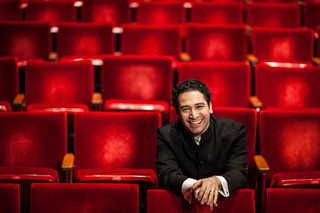|
Back
An Odyssey Completed Houston
Jones Hall
01/09/2014 - & January 11, 12, 2014
John Adams: Short Ride in a Fast Machine
Richard Strauss: Also sprach Zarathustra, opus 30
Gustav Holst: The Planets, opus 32
Women of the Houston Symphony Chorus, Houston Symphony, Andrés Orozco-Estrada (conductor) 
A. Orozco-Estrada (© Julie Soefer)
Music Director Designate Andrés Orozco-Estrada breathed fresh life into the Houston Symphony’s impressive HD Odyssey project. The two-part multimedia presentation still comes across as visually uneven, but it is clear that the driven, athletic direction from the podium has upped the energy level of the players.
Initially seen as summer fare, the first half, The Earth, is an excellent musical and visual coupling. The liftoff footage from nearby NASA is thrillingly coordinated to John Adams’ electrifying Short Ride, while overhead views of earth commingle with Strauss’ philosophical etchings. It is perhaps a missed opportunity that the video footage doesn’t play up more of Strauss’ sectional subtitles. Why, for instance, is Earth still presented as a deserted celestial island during the “Of Science and Learning” portion.
Musically, Orozco-Estrada zipped through the Adams fanfare with thrilling brass response, scurrying upper woodwind flourishes and insistent percussion. Strauss’ tone poem boasted similar execution. Concertmaster Frank Huang’s playing during “The Dance Song” was especially enjoyable. The slight lack of nuance in the slower and softer moments of the piece could easily stem from the necessity of sonic-visual coordination. Orozco-Estrada is slated to record a DVD of The Earth next season, and this will be a thrilling addition to the Houston Symphony discography.
The video portion of the second half, a traversal through The Planets, still grows tiring after the first three or four movements of Holsts’ colorful suite. For all the images—real and conjured—the visual program ends up making the heavenly orbs seem more similar than differentiated. This is certainly not true of Holsts’ music, played through with gusto. Indeed, sometimes enthusiasm seems to have gotten the best of trumpets and trombones, but minor slips in such a demanding piece are certainly excusable. One wonders how much room Orozco-Estrada is given to interpret the piece, but I don’t recall Hans Graf imbuing “Mercury” with such a zesty, leggiero feel, while there seemed to be tighter coordination between women’s chorus and orchestra under the Conductor Laureate’s baton.
Marcus Karl Maroney
|